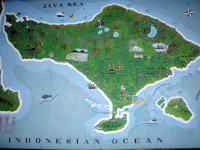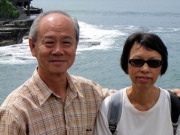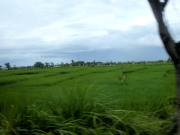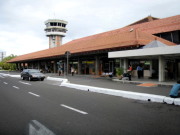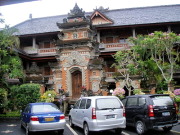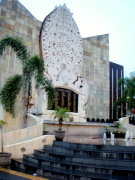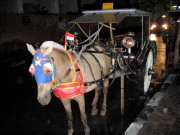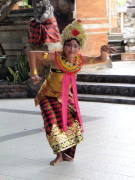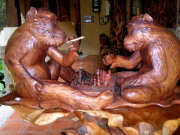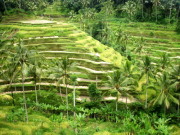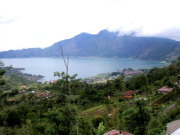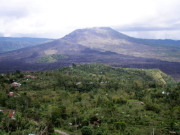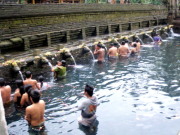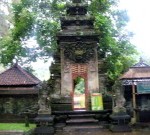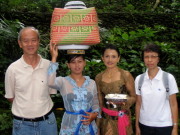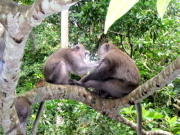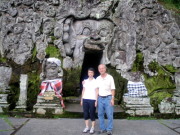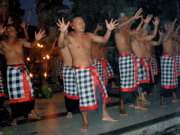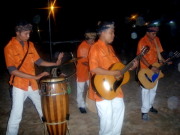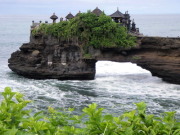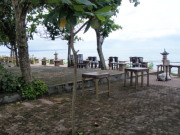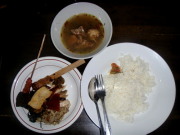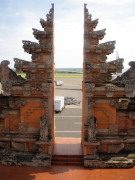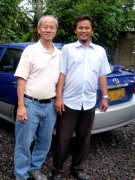Bali Travel
After a trip to Batam Island in September 2008, two months later we went to another Indonesian island known as Bali.
Located a short distance east of Java, Bali is 153 km long and 112 km wide and has an area of about 5,632 sq. km. It has a few active volcanoes in the east such as Mt. Agung (3,142 m), the highest, and Mt. Abang, and Mt. Batur (1,717m).
A large part of its land is covered with volcanic soil making the land suitable for agriculture. Paddy is one of its main crops and is cultivated in the low flat land as well as in terraces on the highlands.
Looking at the map of Bali, the island looks like a bird standing near its egg which represents a smaller island known as Lombok. Denpasar with a population of over 300,000 is the capital of Bali and the international airport, Ngurah Rai International Airport, is in the south of this city.
Although Indonesia is a Muslim-dominant country , over 90% of Bali’s population believe in Hinduism that is mixed with some local Balinese beliefs. It is surprising that the small island has about 20,000 Hindu temples. The temples are built in Balinese architechural style and have narrow entrances and stone
statues of Ramayana characters. The island is commonly known as “The Island of Gods”. Sometimes, it is called “The Paradise on Earth”.
Bali is famous for arts and crafts. Besides, its dances are unique and well-known all over the world. The dances are usually incorporated in dramas that depict stories of Hindu epics of Ramayana mixed with local legendary tales, such as Barong, Legong, Kechak, Pendet, Topeng, Gong Keybar and Baru.
Tourism is the mainstay of Bali. Among all the Indonesian islands, Bali is the most popular tourist destination attracting millions of tourists from all over the world
every year. Its rapid growth in tourism has led to the increase in the living standard of the Balinese. It is commendable that many Balinese take the trouble to learn and speak English.
In 2002, a horrendous bombing in a popular tourist area in Kuta, south of Denpasar, killed 202 people and injured about 200. Most of the casualties were foreigners. It was caused by the Indonesian Muslim terrorists. Then in 2005, a series of terrorist bomb-attacks at Jimbaran and Kuta in southern Bali killed 20 and injured 129. The two bombings in 2002 and 2005 have, undoubtedly,
discouraged tourists from visiting the beautiful island. As a result, they have caused
severe economic hardship to the islanders for several years. To encourage foreigners to visit Bali, the Indonesian government has been taking measures to make the islands safe for tourists. To gain their confidence, the government holds frequent international conferences in Bali.
In November 2008, my wife and I decided to visit Bali, as we thought it was safe to have a short vacation there then.
Day 1 (27 November 2008)
On 27 November 2008, we boarded an Air Asia plane at LCCT at Sepang and flew directly to Bali. In the afternoon, 3 hours and 40 minutes later, we touched down safely at Ngurah Rai International in Bali. Then we were whisked away by a hotel van to a budget hotel known as Puri Dewa Bharata Hotel which we had booked earlier through Air Asia.
Later in the evening, the same hotel van brought us to Kuta town. While travelling in the town, our driver stopped and pointed across the road at a spot and said that at that place a terrorist powerful bomb attack occurred in a bar known as Paddy’s Club killing 202 people and burning down many shops nearby. He then pointed at a large man-made structure known as “Bali Blast Monument” which was erected on 12 October 2004 on the 2nd. anniversary of the bomb attack. It is made of stone with intricate carvings and a large marble plague with names and nationalities of those killed in the bomb attack. Besides, it is flanked by the national flags of the victims.
After dinner at a KFC outlet in Kuta, we decided to walk about in the town. As we were walking along a road, Pantai Road, parallel to the Kuta beach, we saw hotels, bars, restaurants and a lot of tourists. It is a popular tourist place as there is a beautiful sandy beach with a bay. Besides, we saw horse-drawn carriages trotting along the road carrying tourists for joyride. At 11 p.m. we left the place in a taxi for our hotel.
Day 2 (28 November 2008)
On the second day in Bali, we booked a private car with an English-speaking Balinese driver, Nyoman. He was also our tour guide. At about 9.30 a.m., he came
to our hotel to pick us up and then we left to begin our Bali tour. The first place Nyoman brought us was a theatre in Batu Bulan to watch a morning live Balinese performance known as Barong and Kris Dance. It was a play about the fight between Barong, the good spirit, and Rangda, the evil spirit. It was an hour show accompanied on the music by a “gamelan” orchestra and it attracted quite a lot of tourists.
The show began with the Barong dance or “Lion” dance which was boring to watch. It was performed by a strange looking creature which had a tiny head but a huge furry body. Subsequently, the show became interesting. There were two pretty girls in colourful Balinese costumes who amazed us. As they were dancing they moved their hands, legs, heads and body slowly but gracefully. But when they opened their eyes wide and looked
left and right their exposed white large eyeballs frightened the audience.
After the show, we left for Ubud which is a well-known area for factories that produce arts and crafts. We visited three of them at different places. The first one we visited produced batik, then the second one gold and silver jewellery, and the last one carved wooden animals like horses, lions, monkeys and crocodiles, human beings, landscapes, masks, etc. Some of these creatures were life-seized.
As we were passing through Ubud to a highland, Tegallang, we saw hundreds of small shops selling nothing but all kinds of local arts and crafts.
On arrival at Tegallang, we stopped and joined a group of tourists at a vantage-point to see the beautiful scenery of the paddy terraces on steep hill-slopes. At that moment the terraces were dry and the paddy had already been harvested.
Then we moved on to another place, a village known as Kintamani, which is at a height of over 1,750 m. When we arrived there we entered a crowded restaurant, Batur Sari Restaurant, which perched at the edge of a cliff. While having lunch at the back of the restaurant, we feasted our eyes on the breathtaking scenery of the distant landscapes of a volcano, Mount Batur (1,717 m), a deep valley, a higher and larger volcano, Mount Abang, and a large lake, Lake Batur (a crater), with dwellings along its edge.
After enjoying the beautiful sight, we had to pay the restaurant a high price for our meal which cost 121,000 Rp. per person(including the exorbitant 21% tax!).
Our next stop was a coffee farm. While travelling through some villages in the hilly areas, our driver, smilingly, asked us to look out for ladies bathing topless in streams along the road. At first we did not believe him. A few minutes later, we were shocked to see one in a stream.
Soon we arrived at a coffee farm and were treated to a variety of tea and coffee drinks. Looking around, we did not see any coffee or tea plants but a man roasting coffee beans in a little hut. When asked, our driver explained that the area was once a coffee farm but as the area was small, it was planted in a larger area at another place.
Then we continued our journey and soon we arrived at Tampaksiring where we visited an old, large Balinese temple, Tirta Empul Temple. It has a pool where underground water can be seen coming out of its bottom. This so-called “holy water” flows into another pool nearby where Hindu devotees bathe with it to
cleanse themselves of their sins.
The next place we went was a monkey forest, Sacred Monkey Forest Sanctuary, at Pedangtegal. There are hundreds of long-tailed Macagues roaming freely in this forest. Besides, the forest has three temples built in the 14th. Century. We were warned that there were some mischievous monkeys in the forest. They liked to steal or snatch tourists’ possessions like sunglasses, handbags, plastic bags of food, cameras, etc. But when we were there in the late afternoon most of them were
resting in the trees. I guessed they had seen enough of tourists for the day. We met some Balinese women in their traditional clothes in the forest. They were celebrating a festival and had worhipped at the temples. Tourists who want to visit this forest should bring along an insect repellent as there are lots of blood-sucking mosquitoes there.
Our driver then brought us to Bedula to visit a small cave which I think is man-made. It is known as Elephant Cave (Goa Gajah). It is so-called because its front has been carved into an image of an elephant and a small, short tunnel has been
dug to make it into a cave. In the evening, some local people will spend their time meditating in the “cave”. Near the “cave” are some temples destroyed by earthquakes long time ago.
In the evening , our kind driver brought us to Batu Bulan again to see another Balinese performance known as Kecak and Fire Dance. It is about a prince, his beautiful wife and brother who lived in exile in a forest. A lecherous king who liked the prince’s wife asked his prime minister to bring her to his kingdom. The
prime minister then tricked, kidnapped and brought the lady to his king. When the prince discovered the kidnap, he, with the help of a large troop of monkeys, went to fight the king. He, successfully, killed the king and saved his wife.
After the show, we could not believed ourselves that we had visited so many places of interest in one day. As we were feeling tired, the first thing that came to our minds was to go for a Balinese massage. After the massage, we felt rejuvenated but famished. When we asked for a seafood restaurant, our driver brought us to one which is known as Ganesha Restaurant at Kedonganan Beach in Kuta.
We enjoyed the delicious dinner there. It consisted of a boiled crab of 1.4 kg, a sweet and sour grouper, some chilli clams, vegetable and white rice.
While we were having our meal we heard a band of four male Balinese playing musical instruments and singing English oldies to a group of tourists who were also having their meal.
When we have finished our dinner we were shocked that it was already 11 p.m. On the way to our hotel, we apologised to our patient driver for making him wait so long at the restaurant. We told him to come again and fetch us at our hotel for the following morning trip, as he was a good driver-cum-tour guide.
Day 3 (29 November 2009)
Our 3rd. day in Bali was our last day. As we had to leave Bali by plane at 4.50 p.m.we decided to make a short trip to Tanah Lot in the morning to see a famous temple sitting on a hard rock at the Indian Ocean. Our driver, Nyoman, came and brought us to the place in the morning. On arrival, we were awe-stricken to see beautiful coastal landscapes. The coastal land is high which is about 70 m above sea-level and has steep cliffs, promontories, stacks, arches and caves. All these structures have been created by the strong ocean waves.
Perched precariously on an arch is a small temple which is out of bound to the tourists. Not far from this temple is a another one which is built on a solid rock.
The rock becomes an islet when there is a high tide and it is about 100 m from the mainland. The view of the temple on the rock is spectacular.
On the mainland there is a spot near the edge of the cliff and is 70 m above the sea. It commands a panoramic view of the vast expense of the Indian Ocean. On a clear day, the eastern part of Java Island can be seen from this spot. In the evening, tourists go there to watch the sunset. Hence, the place is known as Sunset Terrace.
Having seen enough of the sacred place, we went to the capital of Bali, Denpasar. When we arrived there we stopped at a small restaurant for lunch. As we entered the restaurant we saw on the walls photos of customers and their words of praise for the food served there. We thought we would enjoy the meal there if what the customers said was true. For 50,000 Rp. for a meal per person, we were given a plate of white rice, a bowl of
pork meat soup, and a plate containing a stick of grilled pork meat, a few pieces of roasted pork (“babi guling”) and some vegetable. After taking the food, we felt that it was “so-so” for us.
Then we went to a superstore which is well-stocked with Balinese-made goods, such as clothes, hadbags, belts, souvenirs, arts, handicrafts, preserved foods, etc. It is called Krishna. After buying a few items there we left for the airport. On arrival, we thanked our good driver, Nyoman, tipped him for his excellent service and bade him farewell. Finally, at about 5 p.m. we left Bali and flew back to Malaysia, our homeland.
Well, that was a short but enjoyable vacation in Bali and we hope to visit more foreign places in the near future.
Here, I would like to thank I Nyoman Sudira, our excellent, patient and obliging driver-cum- tour guide, for making our Bali tour an enjoyable and memorable one. Those who are interested in his service can contact him by handphone: 0361-7432274 or at his email address, Lembut_Bali@yahoo.com .
Our next vacation will be in Hanoi City and hope you will read about it when I have visited the place and written about it. Well, I hope you have gained something from what I have written about our Bali trip.
Written by:
Choo Chaw, Kluang, Johor, Malaysia.

